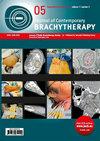早期非小细胞肺癌立体定向体外放射治疗后的抢救性经皮高剂量率支架消融术
IF 1.1
4区 医学
Q4 ONCOLOGY
引用次数: 0
摘要
经立体定向体放射治疗(SBRT)治疗 I 期非小细胞肺癌(NSCLC)后原发肿瘤进展的患者有第二次机会通过挽救性局部治疗(包括肺切除、重复 SBRT 疗程和经皮消融治疗)彻底根除肿瘤。在本文中,我们介绍了本院对 4.3 年前接受过 SBRT 治疗的复发 I 期 NSCLC 患者进行经皮高剂量率 (HDR) brachyablation 治疗的初步经验。复发时肺部肿瘤最大尺寸约为 5 厘米,经组织病理学证实为顽固性鳞状细胞癌,并成功接受了单次 24 Gy HDR 支架消融术治疗。治疗是在CT引导下通过插入两根经皮导管进行的,治疗时间不到20分钟。患者于当天晚些时候出院回家,无需插胸管,每 3 到 6 个月接受一次连续监测扫描,HDR brachyablation 术后 2.8 年和首次 SBRT 术后 7.8 年未发现肺癌进一步发展或并发症。本文章由计算机程序翻译,如有差异,请以英文原文为准。
Salvage percutaneous high-dose-rate brachyablation after stereotactic body radiation therapy for early-stage non-small cell lung cancer
Patients with primary tumor progression after stereotactic body radiation therapy (SBRT) for stage I non-small cell lung cancer (NSCLC) have a second chance at complete tumor eradication with salvage local therapies, including lung resection, repeat course of SBRT, and percutaneous ablative therapies. In this paper, we presented our institution’s initial experience with percutaneous high-dose-rate (HDR) brachyablation for a relapsed stage I NSCLC that had been treated with SBRT 4.3 years earlier. Lung tumor measuring approximately 5 cm in maximum tumor dimension at the time of relapse was histopathologically confirmed to be persistent squamous cell carcinoma, and successfully treated with a single fraction of 24 Gy with HDR brachyablation. Treatment was delivered via two percutaneous catheters inserted under CT-guidance, and treated in less than 20 minutes. The patient was discharged home later the same day without the need for a chest tube, and has been monitored with serial surveillance scans every 3 to 6 months without evidence of further lung cancer progression or complications at 2.8 years post-HDR brachyablation procedure and 7.8 years after initial SBRT.
求助全文
通过发布文献求助,成功后即可免费获取论文全文。
去求助
来源期刊

Journal of Contemporary Brachytherapy
ONCOLOGY-RADIOLOGY, NUCLEAR MEDICINE & MEDICAL IMAGING
CiteScore
2.40
自引率
14.30%
发文量
54
审稿时长
16 weeks
期刊介绍:
The “Journal of Contemporary Brachytherapy” is an international and multidisciplinary journal that will publish papers of original research as well as reviews of articles. Main subjects of the journal include: clinical brachytherapy, combined modality treatment, advances in radiobiology, hyperthermia and tumour biology, as well as physical aspects relevant to brachytherapy, particularly in the field of imaging, dosimetry and radiation therapy planning. Original contributions will include experimental studies of combined modality treatment, tumor sensitization and normal tissue protection, molecular radiation biology, and clinical investigations of cancer treatment in brachytherapy. Another field of interest will be the educational part of the journal.
 求助内容:
求助内容: 应助结果提醒方式:
应助结果提醒方式:


